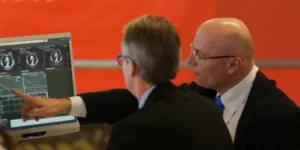We went for the third year running to the European Congress on Radiology which takes place in Vienna. The mood was fairly positive from display vendors, but the markets are not growing strongly. Most of Europe is currently digital, so it is mainly a replacement market, although there is hope that the UK might get into a renewal phase. Eastern Europe and MEA are still growth markets, but they have their own challenges and problems.
The market is very influenced by the PACS software and Dicom standards. Without standards, evolution is quite difficult, although as Barco and others have shown, you can innovate by getting to really understand the user. A couple of years ago, everyone was chasing Barco as the company had exclusive access to 6 megapixel displays which could show dual 3 megapixel images. Last year, the rest caught up, but found that they had missed the best of the market and there was a fair amount of fighting for a small segment, so the promise of 6 megapixel only really benefited the pioneers.
Now, displays are available at up to 14 megapixels, but without the right medical standards and workflows – which go right back to the imager and depend for their development on genuine improvements in diagnosis – the market will be a bit limited.
Of course, the 3 megapixel standards are for radiography, which remains a monochrome application. As Barco said to us, it would help the market if new standards were available for colour displays, but this is bound to take some time to sort out. At the moment, companies are developing their own solutions for “mixed mode” displays. More and more imaging techniques are becoming available and at the conference there was talk of using multiple different kinds of scanner even for mammography. The more things you need to do, the more multi-modality monitors will be needed, as long as there are appropriate standards.
Another story was of new DIN standards for QA in medical imaging in Germany (DIN6868-157) that will impact on verification processes for monitors that were already quite onerous. We heard that once a process has been established for quality assurance by the user, it’s no worse than the old standard, but the development of the QA process is trickier. The standard (in German) can be purchased from http://www.beuth.de/

